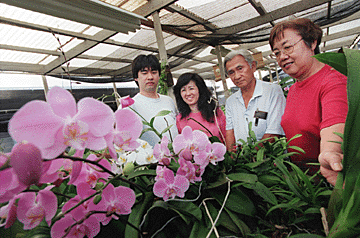



By George F. Lee, Star-Bulletin
Derek Yamamoto, left, his girlfriend Cindy Nose, his dad Tom
Yamamoto and his mom Mae Yamamoto say a phalaenopsis,
such as the plant at the front of the photo, is one of
the easiest varieties to grow.
THE family that sprays together, stays together. Consider the orchid growing Yamamotos of Enchanted Lake. They are Mae and Tom Yamamoto, their son Derek and Derek's girlfriend, Cindy Nose. What started with a couple of potted orchids from friends now envelopes the Yamamotos' yard and has turned into a small business run by the four of them. Orchid breeding a
family affair"I'm still working, so I just help with the spraying and fertilizing," Mae Yamamoto said. "I wash the pots. Tom is retired from Amfac, and he does most of the orchid growing. Derek and Cindy do the hybridizing and the cloning, but we all work together."
"Eight years ago we tore out the lawn and put in the shade house," Derek said. That was when they got serious. Derek and Cindy are both professional orchid hybridizers, working for a larger commercial nursery, but his parents have learned through experience and from membership in the Windward Orchid Society.
Together, they've all learned how to run a business by computer. "We sell on the Internet," Derek said. "I have a Web site, http://www.lava.net/yamaorch. It gives information on orchid growing and there's a catalog with color photos of each orchid we sell. It works fine, because we can update it instantly when something runs out, or we have something new. We get 10 to 20 e-mails a day."
The current hot topic at his Web site is the oncidium intergeneric hybrid, a cross between an oncidium with a miltonia or a brassia, between different species within the orchid family. "It's the flavor of the month," Derek said. "You get new colors and shapes and long-lasting sprays. Some will last six weeks on the plant."
Growers have been hybridizing orchids since 1856 when the head gardener of the orchid section of the nursery firm J. Veitch and Sons of Exeter in England crossed two species of calanthe. In the unfortunate manner of the time and place, the gardener is known only as Dominy, and that orchid bears his name, Calanthe Dominyi. Seven years later, the first intergeneric hybrid was created when a cattleya was crossed with a laelia. Today, there are more than 70,000 hybrids, and every year thousands are registered by commercial nurseries and amateur growers. Each is officially listed with the Royal Horticultural Society in London.
Dominy and other early hybridizers sprinkled the minute seeds from the fruit of one species around the base of the mother plant of a different species, which would produce a random number of new plantlets. Over time, other methods were developed, but hybridizing was still an uncertain science until the development of merisystemic multiplication, or cloning, in the 1960s. The system produced within a very short time a large number of plants exactly the same as the parent. It has helped to popularize the growing of orchids by substantially bringing down the price of the plants.
The Yamamotos also grow their orchids from seeds, a process that can take from two to five years from the time the seeds are gathered and put into flasks to the time when the plant blooms. Clones, by definition, are identical to the parent plant since they are grown from the cells of a newly forming shoot of a single plant. Germinated seeds, however, do not necessarily create new plants that are same as either parent plant, and that, says Derek, is the excitement of hybridizing.
"People want something new, they like variety," he said. "Until the plant flowers, you have no idea of what you've got. Some of the surprises aren't so great, and you throw them out, but when you get a good flower, it's exciting."
For beginning orchid growers, the Yamamotos recommend phalaenopsis as being among the easiest to grow that have showy blossoms. "All you have to remember is that they need shade, and don't allow water to collect in the crown of the leaves. The water rots and kills the plant," Derek said.
Each orchid genus has its own rules for beauty, by which the flower is judged in an orchid show. "Take a vanda," Derek said. "You want a good flat flower in a big ball of blossoms. In a cattleya, you look for a full lip and space between the petals." The Yamamotos hand water their orchids twice a week, and mist them during very hot weather.
They spray a liquid fertilizer on their plants and use a mixture of hapu and fir bark as the planting medium. Derek prefers clay pots to plastic pots because they are heavier and less likely to blow over, and have better drainage.
The Yamamotos will all attend this weekend's Windward Orchid Society's Spring Show, selling some of their prized plants and entering several in the competition. They or other orchid experts will be on hand for the entire run of the show to answer questions on orchid culture, suggest the right orchid for where you live, and tell you how to care for it.
Wonderland of Orchids
Windward Orchid Society's 20th annual spring show
When: 9 a.m. to 9 p.m. today and tomorrow, 9 a.m. to 4 p.m. Sunday
Where: King Intermediate School, 46-155 Kamhemaha Highway, Kaneohe
Cost: $2 donation; persons older than 65 admitted free
Gardening Calendar in Do It Electric!
Send queries along with name and phone number to:
Evergreen by Lois Taylor, Honolulu Star-Bulletin, P.O. Box 3080, Honolulu 96802.
Or send e-mail to features@starbulletin.com.
Please be sure to include a phone number.
Evergreen by Lois Taylor is a regular Friday feature of the
Honolulu Star-Bulletin. © 1998 All rights reserved.